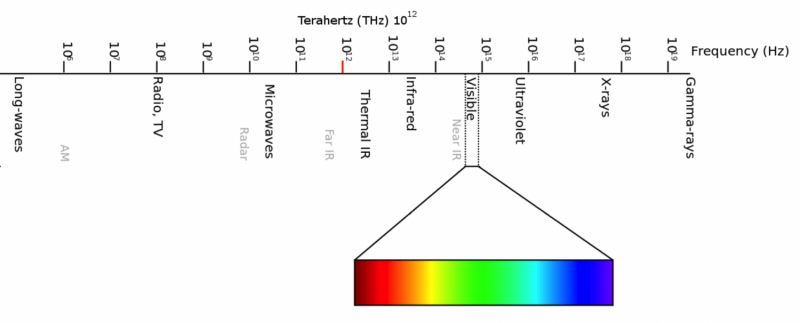Terahertz spectroscopy—the new tool to detect art fraud

When we look at a painting, how do we know it's a genuine piece of art?
Everything we see with the unaided eye in a painting – from the Australian outback images of Albert Namatjira or Russell Drysdale, to the vibrant works of Pro Hart – is thanks to the mix of colours that form part of the visible spectrum.
But if we look at the painting in a different way, at a part of the spectrum that is invisible to our eyes, then we can see something very different.
As our recently published research shows, it could even help us detect art fraud.
A matter of frequency
The electromagnetic spectrum ranges from very high-frequency gamma rays down to the extremely low-frequency radiation of just a few hertz. Hertz is the unit of measurement for frequency.
The frequency of colours in the visible spectrum range from blue, at about 800 terahertz (THz), through to red at about 400THz (1 THz = 1012 or 1,000,000,000,000 hertz).
If we drop to frequencies below the visible spectrum we find the near-infrared at about 300THz and then the mid-infrared at about 30THz.
Then comes the far-infrared and at last we meet the frequencies around 1THz.
Continuing even further brings us to microwaves and radio waves where frequencies range from the gigahertz down to kilohertz. Thus the terahertz part of the electromagnetic spectrum lies between the radio and the visible parts – in other words, between electronics and photonics.
Things can look very different when viewed with "eyes" that can see in the terahertz range. Some things that are transparent to visible light, such as water, are opaque to terahertz light.
Conversely, some things that visible light won't penetrate, such as black plastic, readily transmit terahertz radiation.
Intriguingly, two objects that have the same colour when viewed by the unassisted eye may transmit terahertz radiation differently. So their terahertz signal can be used to tell them apart.
Pigments and colour
This points to the potential use of terahertz radiation in differentiating paints and pigments. Terahertz spectroscopy can distinguish different pigments with similar colours.
We recently used terahertz spectroscopy to distinguish between three related pigments. All come from a family of chemical compounds called quinacridones. These are used widely in producing stable, reproducible pigments that range in colour from red to violet.
Measurements at the University of Wollongong provided the experimental data in the range of 1THz to 10THz. Numerical modelling at Syracuse University (New York) reproduced the experimental data, and gave physical insight into the origin of the features observed.
The combined experimental and theoretical work, published last month in the Journal of Physical Chemistry, unequivocally demonstrates that terahertz spectroscopy is able to distinguish three different quinacridones.
This brings us to the subject of art authentication – or more importantly, detecting cases of art fraud.
Art fraud
Museums, galleries and collectors are typically very protective of their art collections, but terahertz spectroscopy is well suited to examining their works.
While terahertz spectrometers are often located in laboratories, there are also portable models.

Unlike an analysis that requires removing and consuming some material (by reacting it with chemicals, or burning it), there is no contact made with the material, and thus no harm done to the artwork.
The terahertz radiation simply shines on the painting, and the transmitted radiation is measured. The low energy and low density of terahertz radiation means that the painting is not damaged in any way.
This all makes it suitable for examining art in a way that does not damage it and can be performed where it is located – in a gallery, or home, or almost anywhere.
From theory to practice
So how can terahertz spectroscopy assist in detecting art fraud in practice?
Here's an example. Let's say terahertz spectroscopy picks up a quinacridone pigment in a painting. Quinacridone is an artificial material that was first synthesised in 1935, so the painting must date from 1935 or later.
Any claim that the painting is a work by Leonardo da Vinci (who died in 1519), Vincent van Gogh (died 1890) or Claude Monet (died 1926) could therefore be dismissed. Any claim the the work was by an artist who worked after 1935 could not be so easily disproved on this basis.
Of course, other physical methods than terahertz spectroscopy may be applied to analyse paintings. One direct way to analyse art work is by sophisticated, quantitative measurements of the visible spectrum.
Artworks may also be interrogated by other species of light that lie above the blue end visible spectrum. Here the ultraviolet (uv) photons are higher in energy than visible photons. That means they can put energy into a material that is re-radiated as visible photons.
This is the phenomenon of fluorescence, and uv-fluorescence is an established tool in art conservation.
Moving further above the ultraviolet, X-rays may be used to examine works of art. For example, X-ray fluorescence at the Australian Synchrotron has been used to find hidden layers in works by Degas and Streeton.
A genuine fake?
There are many aspects to authenticating an artwork, the physical examination being but one of them.
Nonetheless, technical analysis of the materials used – the paints, the canvas, the frames – plays a fundamental role, and that is where terahertz spectroscopy contributes.
But other approaches also play a role. For example, documentation such as records of sales may provide key evidence, as may the more subtle appraisal of style by art historians.
The perceptions of people who assess and buy art is itself an important factor. The word of the artist might be thought to be definitive, but even this has been overruled by expert opinion, as in the case of Lucian Freud.
Finally, the legal dimension is critical, as has been reported recently in the quashing of the art fraud convictions of Peter Gant and Mohamed Siddique. These related to the paintings Blue Lavender Bay, Orange Lavender Bay, and Through the Window. At issue was whether the paintings were the work of Brett Whiteley.
Other uses
Of course, art fraud is just one application of terahertz spectroscopy. There are many more.
Able to penetrate paper and cardboard, terahertz radiation can be used to look inside envelopes for contraband, or inside packaged food for contamination.
Terahertz methods have been used to assess burns and to monitor the hydration of plants.
As better terahertz sources, detectors and components are developed, the range of applications will further expand.
Provided by The Conversation
This article was originally published on The Conversation. Read the original article.![]()



















